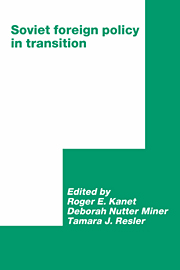Book contents
- Frontmatter
- Contents
- List of tables
- List of contributors
- Preface
- Introduction
- Part I The Soviet Union and the international political system
- Part II The Soviet Union and Europe
- 2 The changing Soviet–East European relationship
- 3 Soviet–Nordic relations in the era of perestroika and new thinking
- 4 Soviet signals to the Nordic countries during the Lithuanian crisis of 1990
- 5 Neutrality and new thinking
- Part III The Soviet Union and the developing world: global trends
- Part IV The Soviet Union and the developing world: regional and country case studies
- Part V Conclusion
- Index
3 - Soviet–Nordic relations in the era of perestroika and new thinking
Published online by Cambridge University Press: 05 February 2012
- Frontmatter
- Contents
- List of tables
- List of contributors
- Preface
- Introduction
- Part I The Soviet Union and the international political system
- Part II The Soviet Union and Europe
- 2 The changing Soviet–East European relationship
- 3 Soviet–Nordic relations in the era of perestroika and new thinking
- 4 Soviet signals to the Nordic countries during the Lithuanian crisis of 1990
- 5 Neutrality and new thinking
- Part III The Soviet Union and the developing world: global trends
- Part IV The Soviet Union and the developing world: regional and country case studies
- Part V Conclusion
- Index
Summary
Since the early 1960s the Nordic subregion has been an island of tranquility and stability, the result of structural and political developments in the international system initiated in the postwar years. Both in the military and the political spheres the confrontations between the Nordic countries and the Soviet Union as an emerging superpower were replaced by a relationship characterized by mutual accommodation between conflicting ideologies and interests.
This relatively calm and stable system is now in flux. All the pillars of the traditional system are changing. The immediate factor behind the changes is, of course, the revolution in Soviet domestic and foreign policy. But coalescing with this development are structural changes in the military, political, and economic environment of the region which have been underway for at least the last decade.
Perestroika and new political thinking in the Soviet Union as well as the dramatic changes in the international arena, especially the emergence of the Baltic republics as political actors, have swept away the traditional pattern of Soviet–Nordic relations and created a new one. The pattern has evolved from one characterized by Soviet dominance to one in which the Nordic countries have been able to support the Baltic republics without jeopardizing relations with Moscow. This chapter attempts to grasp the contours of the emerging new Nordic system and especially those aspects which determine relations with the Soviet Union. The first part summarizes the main characteristics of the Nordic–Soviet relationship up to the mid-1980s.
- Type
- Chapter
- Information
- Soviet Foreign Policy in Transition , pp. 49 - 69Publisher: Cambridge University PressPrint publication year: 1992
- 2
- Cited by



